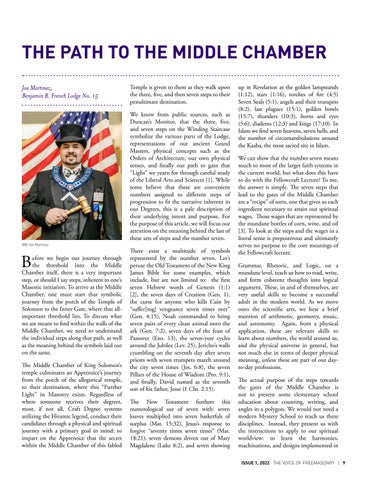THE PATH TO THE MIDDLE CHAMBER Joe Martinez, Benjamin B. French Lodge No. 15
Temple is given to them as they walk upon the three, five, and then seven steps to their penultimate destination. We know from public sources, such as Duncan’s Monitor, that the three, five, and seven steps on the Winding Staircase symbolize the various parts of the Lodge, representations of our ancient Grand Masters, physical concepts such as the Orders of Architecture, our own physical senses, and finally our path to gain that “Light” we yearn for through careful study of the Liberal Arts and Sciences [1]. While some believe that these are convenient numbers assigned to different steps of progression to fit the narrative inherent in our Degrees, this is a pale description of their underlying intent and purpose. For the purpose of this article, we will focus our attention on the meaning behind the last of these sets of steps and the number seven.
WB Joe Martinez
B
efore we begin our journey through the threshold into the Middle Chamber itself, there is a very important step, or should I say steps, inherent to one’s Masonic initiation. To arrive at the Middle Chamber, one must start that symbolic journey from the porch of the Temple of Solomon to the Inner Gate, where that allimportant threshold lies. To discuss what we are meant to find within the walls of the Middle Chamber, we need to understand the individual steps along that path, as well as the meaning behind the symbols laid out on the same. The Middle Chamber of King Solomon’s temple culminates an Apprentice’s journey from the porch of the allegorical temple, to their destination, where this “Further Light” in Masonry exists. Regardless of where someone receives their degrees, most, if not all, Craft Degree systems utilizing the Hiramic legend, conduct their candidates through a physical and spiritual journey with a primary goal in mind: to impart on the Apprentice that the secret within the Middle Chamber of this fabled
There exist a multitude of symbols represented by the number seven. Let’s peruse the Old Testament of the New King James Bible for some examples, which include, but are not limited to: the first seven Hebrew words of Genesis (1:1) [2], the seven days of Creation (Gen. 1), the curse for anyone who kills Cain by “suffer[ing] vengeance seven times over” (Gen. 4:15), Noah commanded to bring seven pairs of every clean animal onto the ark (Gen. 7:2), seven days of the feast of Passover (Exo. 13), the seven-year cycles around the Jubilee (Lev. 25), Jericho’s walls crumbling on the seventh day after seven priests with seven trumpets march around the city seven times (Jos. 6:8), the seven Pillars of the House of Wisdom (Pro. 9:1), and finally, David named as the seventh son of his father, Jesse (1 Chr. 2:15). The New Testament furthers this numerological use of seven with: seven loaves multiplied into seven basketfuls of surplus (Mat. 15:32), Jesus’s response to forgive “seventy times seven times” (Mat. 18:21), seven demons driven out of Mary Magdalene (Luke 8:2), and seven showing
up in Revelation as the golden lampstands (1:12), stars (1:16), torches of fire (4:5) Seven Seals (5:1), angels and their trumpets (8:2), last plagues (15:1), golden bowls (15:7), thunders (10:3), horns and eyes (5:6), diadems (12:3) and kings (17:10). In Islam we find seven heavens, seven hells, and the number of circumambulations around the Kaaba, the most sacred site in Islam. We can show that the number seven means much to most of the larger faith systems in the current world, but what does this have to do with the Fellowcraft Lecture? To me, the answer is simple. The seven steps that lead to the gates of the Middle Chamber are a “recipe” of sorts, one that gives us each ingredient necessary to attain our spiritual wages. Those wages that are represented by the mundane bottles of corn, wine, and oil [3]. To look at the steps and the wages in a literal sense is preposterous and ultimately serves no purpose to the core meanings of the Fellowcraft lecture. Grammar, Rhetoric, and Logic, on a mundane level, teach us how to read, write, and form coherent thoughts into logical argument. These, in and of themselves, are very useful skills to become a successful adult in the modern world. As we move onto the scientific arts, we hear a brief mention of arithmetic, geometry, music, and astronomy. Again, from a physical application, these are relevant skills to learn about numbers, the world around us, and the physical universe in general, but not much else in terms of deeper physical meaning, unless these are part of our dayto-day professions. The actual purpose of the steps towards the gates of the Middle Chamber is not to present some elementary school education about counting, writing, and angles in a polygon. We would not need a modern Mystery School to teach us these disciplines. Instead, they present us with the instructions to apply to our spiritual worldview: to learn the harmonies, machinations, and designs implemented in ISSUE 1, 2022 THE VOICE OF FREEMASONRY | 9











